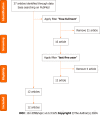Emerging roles of microRNAs as diagnostics and potential therapeutic interest in type 2 diabetes mellitus
- PMID: 38322458
- PMCID: PMC10841963
- DOI: 10.12998/wjcc.v12.i3.525
Emerging roles of microRNAs as diagnostics and potential therapeutic interest in type 2 diabetes mellitus
Abstract
Background: Type 2 diabetes mellitus (T2DM) is a metabolic disease of impaired glucose utilization. Uncontrolled high sugar levels lead to advanced glycation end products (AGEs), which affects several metabolic pathways by its receptor of advanced glycation end products (RAGE) and causes diabetic complication. MiRNAs are small RNA molecules which regulate genes linked to diabetes and affect AGEs pathogenesis, and target tissues, influencing health and disease processes.
Aim: To explore miRNA roles in T2DM's metabolic pathways for potential therapeutic and diagnostic advancements in diabetes complications.
Methods: We systematically searched the electronic database PubMed using keywords. We included free, full-length research articles that evaluate the role of miRNAs in T2DM and its complications, focusing on genetic and molecular disease mechanisms. After assessing the full-length papers of the shortlisted articles, we included 12 research articles.
Results: Several types of miRNAs are linked in metabolic pathways which are affected by AGE/RAGE axis in T2DM and its complications. miR-96-5p, miR-7-5p, miR-132, has_circ_0071106, miR-143, miR-21, miR-145-5p, and more are associated with various aspects of T2DM, including disease risk, diagnostic markers, complications, and gene regulation.
Conclusion: Targeting the AGE/RAGE axis, with a focus on miRNA regulation, holds promise for managing T2DM and its complications. MiRNAs have therapeutic potential as they can influence the metabolic pathways affected by AGEs and RAGE, potentially reducing inflammation, oxidative stress, and vascular complications. Additionally, miRNAs may serve as early diagnostic biomarkers for T2DM. Further research in this area may lead to innovative therapeutic strategies for diabetes and its associated complications.
Keywords: Advanced glycation end products; MicroRNAs; Receptor for advanced glycation end products; Type 2 diabetes mellitus.
©The Author(s) 2024. Published by Baishideng Publishing Group Inc. All rights reserved.
Conflict of interest statement
Conflict-of-interest statement: All the authors declare that they have no conflict of interest.
Figures






Similar articles
-
Advanced Glycation End Products and Diabetes Mellitus: Mechanisms and Perspectives.Biomolecules. 2022 Apr 4;12(4):542. doi: 10.3390/biom12040542. Biomolecules. 2022. PMID: 35454131 Free PMC article. Review.
-
Association of RAGE gene polymorphism with circulating AGEs level and paraoxonase activity in relation to macro-vascular complications in Indian type 2 diabetes mellitus patients.Gene. 2013 Sep 10;526(2):325-30. doi: 10.1016/j.gene.2013.05.013. Epub 2013 May 27. Gene. 2013. PMID: 23721855
-
miR-4428 and miR-185-5p as Key Modulators of Insulin Sensitivity and Glucose Homeostasis: Insights into Pathways and Therapeutic Potential in Type 2 Diabetes Mellitus.Biology (Basel). 2025 Apr 15;14(4):424. doi: 10.3390/biology14040424. Biology (Basel). 2025. PMID: 40282289 Free PMC article.
-
Exploring the pathogenesis of type 2 diabetes mellitus intestinal damp-heat syndrome and the therapeutic effect of Gegen Qinlian Decoction from the perspective of exosomal miRNA.J Ethnopharmacol. 2022 Mar 1;285:114786. doi: 10.1016/j.jep.2021.114786. Epub 2021 Nov 8. J Ethnopharmacol. 2022. PMID: 34763043
-
Circulating microRNAs as predictive biomarkers of coronary artery diseases in type 2 diabetes patients.J Clin Lab Anal. 2022 May;36(5):e24380. doi: 10.1002/jcla.24380. Epub 2022 Mar 29. J Clin Lab Anal. 2022. PMID: 35349731 Free PMC article. Review.
Cited by
-
An Artificial Intelligence-Based Fuzzy Logic System for Periodontitis Risk Assessment in Patients with Type 2 Diabetes Mellitus.Bioengineering (Basel). 2025 Feb 20;12(3):211. doi: 10.3390/bioengineering12030211. Bioengineering (Basel). 2025. PMID: 40150676 Free PMC article.
-
Advancing Cholangiocarcinoma Diagnosis: The Role of Liquid Biopsy and CRISPR/Cas Systems in Biomarker Detection.Cancers (Basel). 2025 Jun 26;17(13):2155. doi: 10.3390/cancers17132155. Cancers (Basel). 2025. PMID: 40647454 Free PMC article. Review.
-
Identifying miRNA Signatures Associated with Pancreatic Islet Dysfunction in a FOXA2-Deficient iPSC Model.Stem Cell Rev Rep. 2024 Oct;20(7):1915-1931. doi: 10.1007/s12015-024-10752-0. Epub 2024 Jun 25. Stem Cell Rev Rep. 2024. PMID: 38916841 Free PMC article.
References
-
- Saeedi P, Petersohn I, Salpea P, Malanda B, Karuranga S, Unwin N, Colagiuri S, Guariguata L, Motala AA, Ogurtsova K, Shaw JE, Bright D, Williams R IDF Diabetes Atlas Committee. Global and regional diabetes prevalence estimates for 2019 and projections for 2030 and 2045: Results from the International Diabetes Federation Diabetes Atlas, 9(th) edition. Diabetes Res Clin Pract. 2019;157:107843. - PubMed
-
- Peppa M, Vlassara H. Advanced glycation end products and diabetic complications: a general overview. Hormones (Athens) 2005;4:28–37. - PubMed
LinkOut - more resources
Full Text Sources

